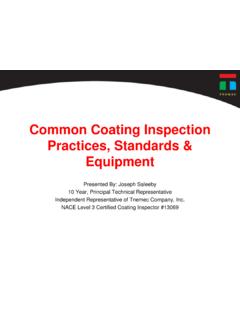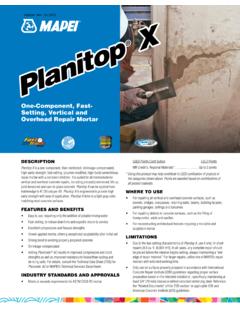Transcription of NACE No. 5/SSPC-SP 12 - iso-iran.ir
1 Item No. 21076. Joint Surface Preparation Standard nace no . 5/SSPC-SP 12. Surface Preparation and Cleaning of Metals by Waterjetting Prior to Recoating This NACE International (NACE)/ sspc : The Society for Protective Coatings standard represents a consensus of those individual members who have reviewed this document, its scope, and provisions. It is intended to aid the manufacturer, the consumer, and the general public. Its acceptance does not in any respect preclude anyone, whether he has adopted the standard or not, from manufacturing, marketing, purchasing, or using products, processes, or procedures not addressed in this standard. Nothing contained in this NACE/ sspc standard is to be construed as granting any right, by implication or otherwise, to manufacture, sell, or use in connection with any method, apparatus, or product covered by Letters Patent, or as indemnifying or protecting anyone against liability for infringement of Letters Patent. This standard represents current technology and should in no way be interpreted as a restriction on the use of better procedures or materials.
2 Neither is this standard intended to apply in all cases relating to the subject. Unpredictable circumstances may negate the usefulness of this standard in specific instances. NACE and sspc . assume no responsibility for the interpretation or use of this standard by other parties and accept responsibility for only those official interpretations issued by NACE or sspc in accordance with their governing procedures and policies which preclude the issuance of interpretations by individual volunteers. Users of this NACE/ sspc standard are responsible for reviewing appropriate health, safety, environmental, and regulatory documents and for determining their applicability in relation to this standard prior to its use. This NACE/ sspc standard may not necessarily address all potential health and safety problems or environmental hazards associated with the use of materials, equipment, and/or operations detailed or referred to within this standard. Users of this NACE/ sspc standard are also responsible for establishing appropriate health, safety, and environmental protection practices, in consultation with appropriate regulatory authorities if necessary, to achieve compliance with any existing applicable regulatory requirements prior to the use of this standard.
3 CAUTIONARY NOTICE: NACE/ sspc standards are subject to periodic review, and may be revised or withdrawn at any time without prior notice. The user is cautioned to obtain the latest edition. NACE and sspc require that action be taken to reaffirm, revise, or withdraw this standard no later than five years from the date of initial publication. Revised July 2002. Approved 1995. ISBN 1-57590-157-9. 2002, NACE International NACE International sspc : The Society for Protective Coatings 1440 South Creek Drive 40 24th Street, Sixth Floor Houston, TX 77084-4906 Pittsburgh, PA 15222. (telephone +1 281/228-6200) (telephone +1 412/281-2331). Printed by NACE International nace no . 5/SSPC-SP 12. _____. Foreword This joint standard describes the surface preparation technique known as waterjetting. This technique provides an alternative method of removing coating systems or other materials from metal surfaces, including lead-based paint systems, prior to the application of a protective coating or lining system.
4 This standard is intended for use by coating or lining specifiers, applicators, inspectors, or others whose responsibility it may be to define a standard degree of surface 1. cleanliness. Since publication of NACE Standard RP0172, surface preparation using waterjetting equipment has found acceptance as a viable method. Waterjetting can be effective in removing water-soluble surface contaminants that may not be removed by dry abrasive blasting alone, specifically, those contaminants found at the bottom of pits of severely corroded metallic substrates. Waterjetting also helps to remove surface grease and oil, rust, shot-creting spatter, and existing coatings and linings. Waterjetting is also used in areas where abrasive blasting is not a feasible method of surface preparation. The use of a high-pressure water stream to strip existing coatings and clean the surface has advantages over open dry abrasive blasting with respect to worker respiratory exposure and work area air quality.
5 Respiratory requirements for waterjetting may be less stringent than for other methods of surface preparation. Waterjetting does not provide the primary anchor pattern on steel known to the coatings industry as profile. The coatings industry uses waterjetting primarily for recoating or relining projects in which there is an adequate preexisting profile. Waterjetting has application in a broad spectrum of industries. It is used when high-performance coatings require extensive surface preparation and/or surface decontamination. This standard was originally prepared by NACE/ sspc Joint Task Group TGD. It was technically revised in 2002 by Task Group 001 on Surface Preparation by High-Pressure Waterjetting. This Task Group is administered by Specific Technology Group (STG) 04 on Protective Coatings and Linings Surface Preparation, and is sponsored by STG 02 on Protective Coatings and Linings . Atmospheric, and STG 03 on Protective Coatings and Linings Immersion/Buried. This standard is issued by NACE International under the auspices of STG 04, and by sspc Group Committee on Surface Preparation.
6 _____. NACE International i nace no . 5/SSPC-SP 12. _____. Joint Surface Preparation Standard nace no . 5/SSPC-SP 12. Surface Preparation and Cleaning of Metals by Waterjetting Prior to Recoating Contents 1. General .. 1. 2. Definitions .. 1. 3. Surface Cleanliness Requirements .. 1. 4. Flash Rusted Surface Requirements .. 3. 5. Occupational and Environmental Requirements .. 3. 6. Cautionary Notes .. 3. 4. Bibliography .. 5. Appendix A: Surface Cleanliness Conditions of Nonvisible Contaminants and Procedures for Extracting and Analyzing Soluble Salts .. 6. Appendix B: Waterjetting Equipment .. 7. Appendix C: Principles of Waterjetting .. 7. Table 1: Visual Surface Preparation Definitions .. 2. Table 2: Flash Rusted Surface Definitions .. 3. Table A1: Description of Nonvisible Surface Cleanliness Definitions (NV) .. 6. Table C1: Typical Pressurized Water Systems .. 8. _____. ii NACE International nace no . 5/SSPC-SP 12. _____. Section 1: General This standard describes the use of waterjetting to ach- standard does not address the cleaning of concrete.
7 Clean- 2. ieve a defined degree of cleaning of surfaces prior to the ing of concrete is discussed in nace no . 6/ sspc SP-13. application of a protective coating or lining system. These requirements include the end condition of the surface plus Appendices A, B, and C give additional information on materials and procedures necessary to verify the end condi- waterjetting equipment, production rates, procedures, and tion. This standard is limited in scope to the use of water principles. only. Visual Reference Photographs: NACE VIS 7/ sspc - This standard is written primarily for applications in VIS 4, Guide and Reference Photographs for Steel Sur- 3. which the substrate is carbon steel. However, waterjetting faces Prepared by Waterjetting, provides color photo- can be used on nonferrous substrates such as bronze, graphs for the various grades of surface preparation as a aluminum, and other metals such as stainless steel. This function of the initial condition of the steel. The latest issue of the reference photographs should be used.
8 _____. Section 2: Definitions This section provides basic waterjetting definitions. Low-Pressure Water Cleaning (LP WC): Additional definitions relevant to waterjetting are contained Water cleaning performed at pressures less than 34. (1). in the WaterJet Technology Association's Recommended MPa (5,000 psig). This is also called power washing . Practices for the Use of Manually Operated High-Pressure or pressure washing.. 4. Waterjetting Equipment.. High-Pressure Water Cleaning (HP WC): Waterjetting (WJ): Use of standard jetting Water cleaning performed at pressures from 34 to 70. water discharged from a nozzle at pressures of 70 MPa MPa (5,000 to 10,000 psig). (10,000 psig) or greater to prepare a surface for coating or inspection. Waterjetting uses a pressurized stream High-Pressure Waterjetting (HP WJ): Water- of water with a velocity that is greater than 340 m/s jetting performed at pressures from 70 to 210 MPa (1,100 ft/s) when exiting the orifice. Waterjetting does (10,000 to 30,000 psig).
9 Not produce an etch or profile of the magnitude cur- rently recognized by the coatings industry. Rather, it Ultrahigh-Pressure Waterjetting (UHP WJ): exposes the original abrasive-blasted surface profile if Waterjetting performed at pressures above 210 MPa one exists. (30,000 psig). Water Cleaning (WC): Use of pressurized Nonvisible Contamination (NV): Nonvisible water discharged from a nozzle to remove unwanted contamination is the presence of organic matter, such matter from a surface. as very thin films of oil and grease, and/or soluble ionic materials such as chlorides, ferrous salts, and sulfates Standard Jetting Water: Water of sufficient that remain on the substrate after cleaning. purity and quality that it does not impose additional contaminants on the surface being cleaned and does Visible Surface Cleanliness (VC): Visible sur- not contain sediments or other impurities that are face cleanliness is the visible condition of the substrate, destructive to the proper functioning of waterjetting when viewed without magnification, after cleaning.
10 Equipment. _____. Section 3: Surface Cleanliness Requirements Table 1 lists four definitions of surface cleanliness in As part of the surface preparation, deposits of terms of visible contaminants. A surface shall be prepared oil, grease, and foreign matter must be removed by to one of these four visual conditions prior to recoating. waterjetting, by water cleaning, by steam cleaning, by 5. methods in accordance with sspc -SP 1, or by _____. (1). WaterJet Technology Association, 917 Locust Street, Suite 1100, St. Louis, MO 63101-1419. NACE International 1. nace no . 5/SSPC-SP 12. another method agreed upon by the contracting part- prepared to one of these flash rusted surface conditions ies. prior to recoating. NOTE: Direct correlation to existing dry media The specifier shall use one of the visual surface prepar- blasting standards is inaccurate or inappropriate when ation definitions (WJ-1 to WJ-4 in Table 1) and, when describing the capabilities of water cleaning and the deemed necessary, one of the flash rust definitions.





